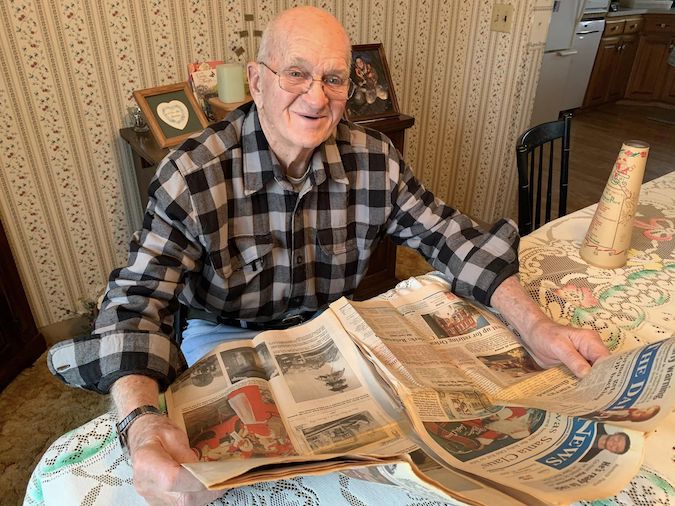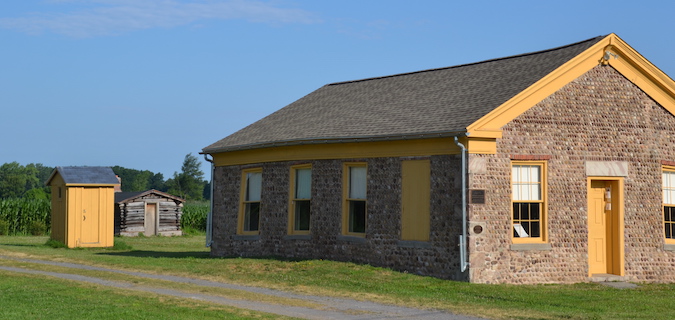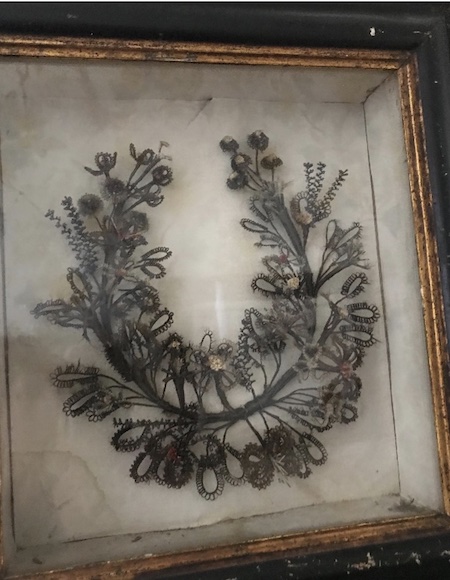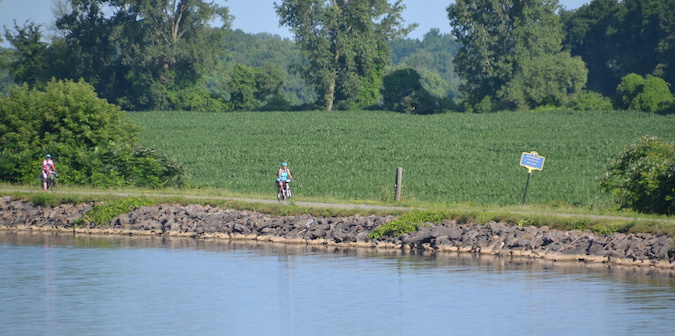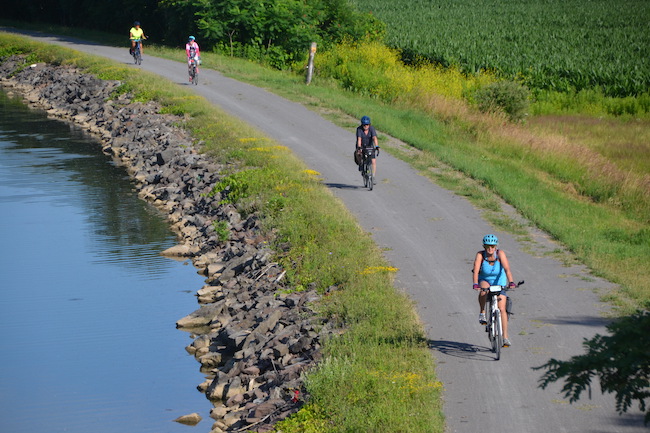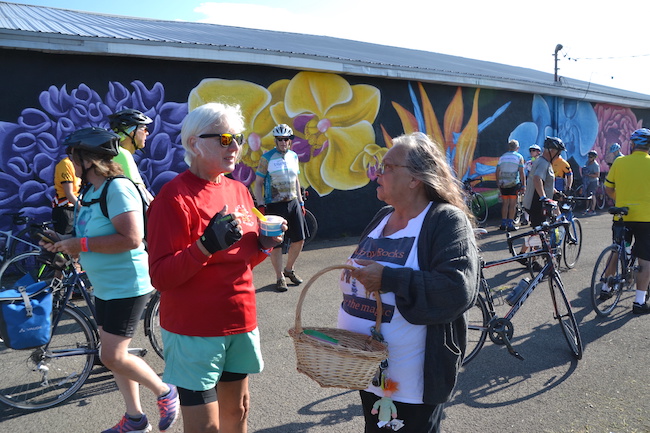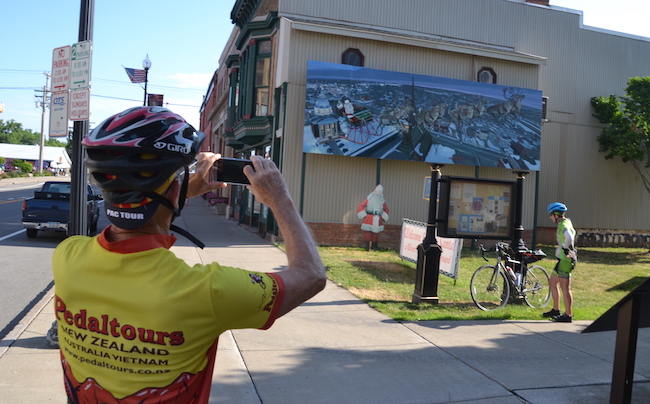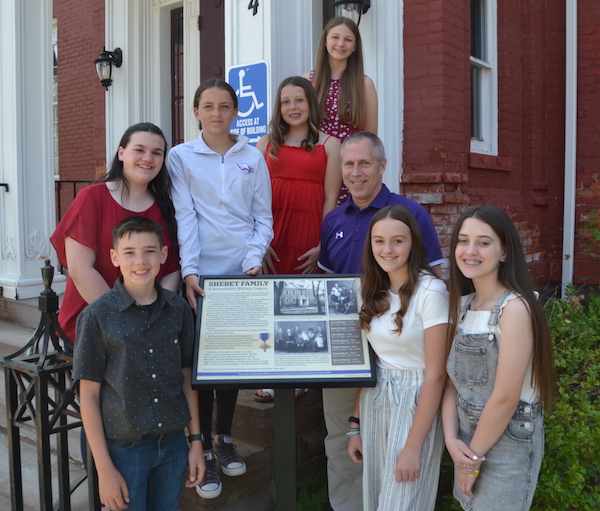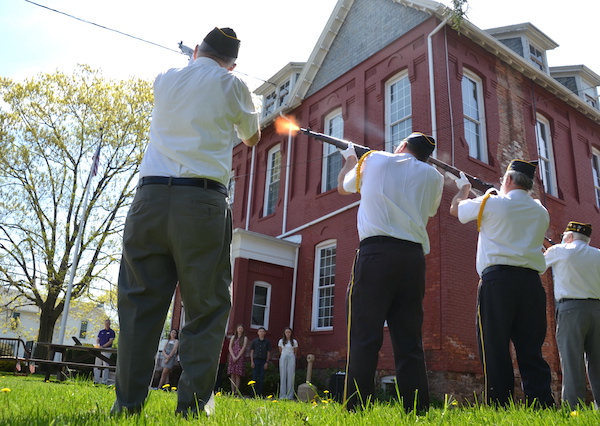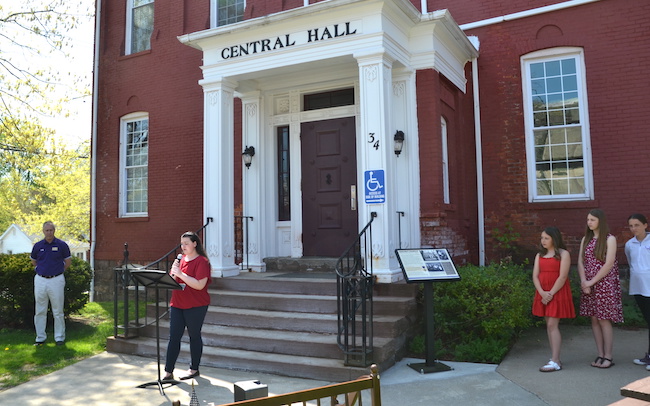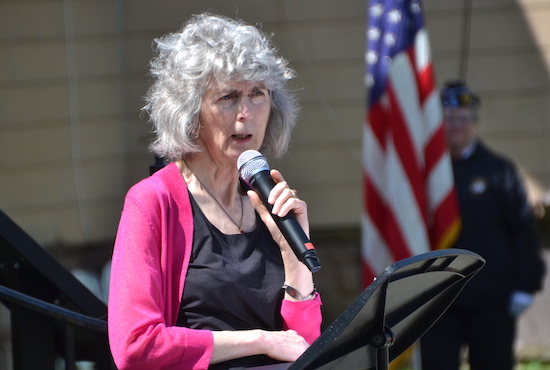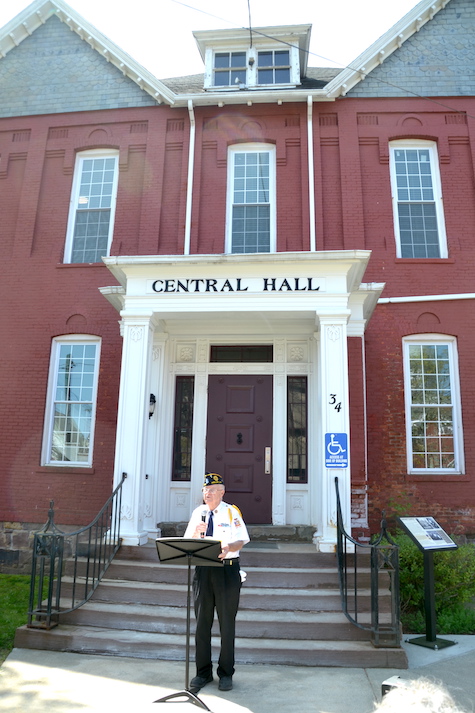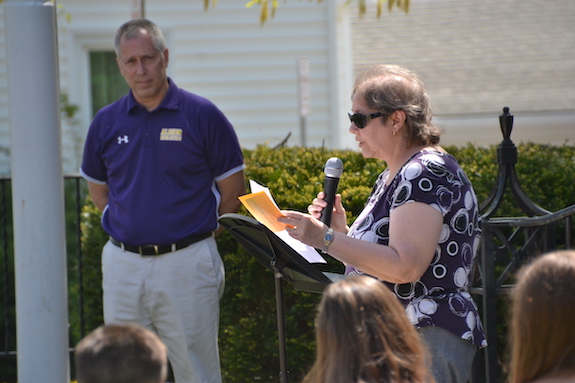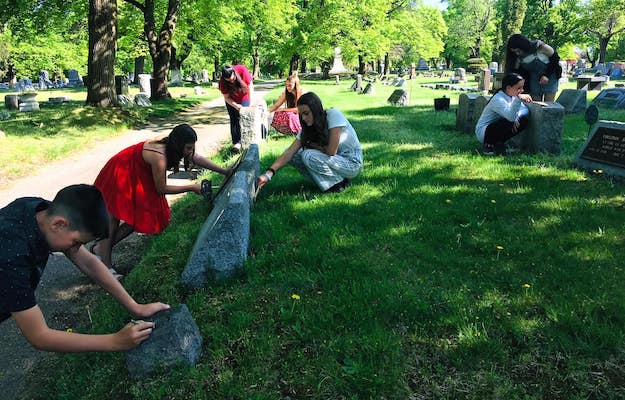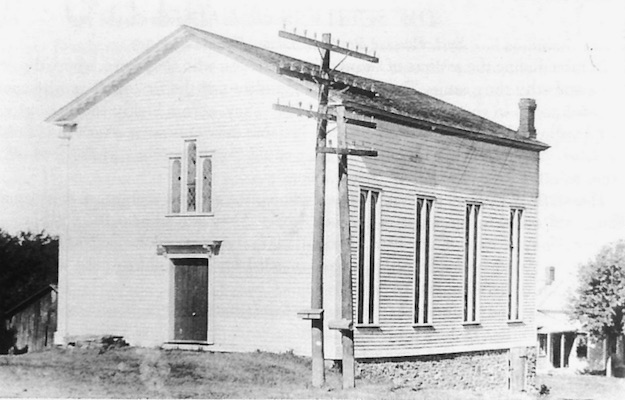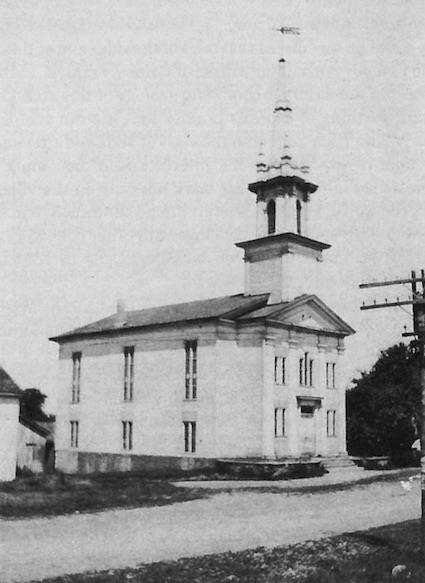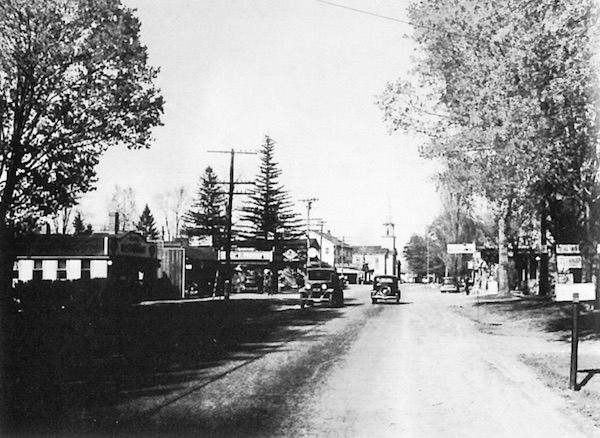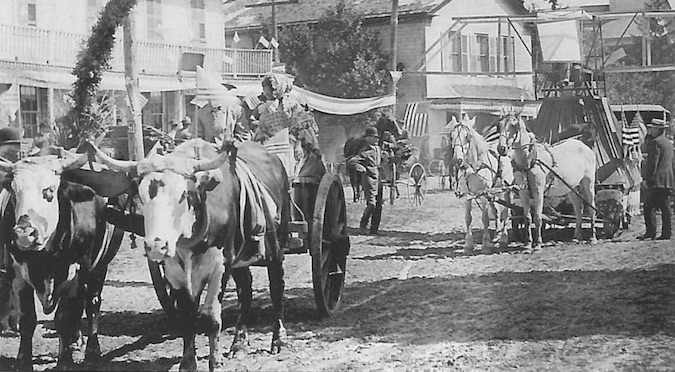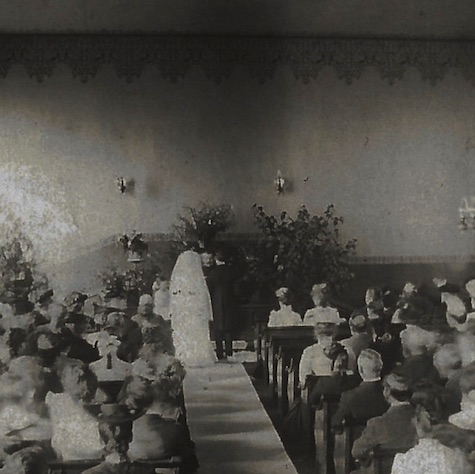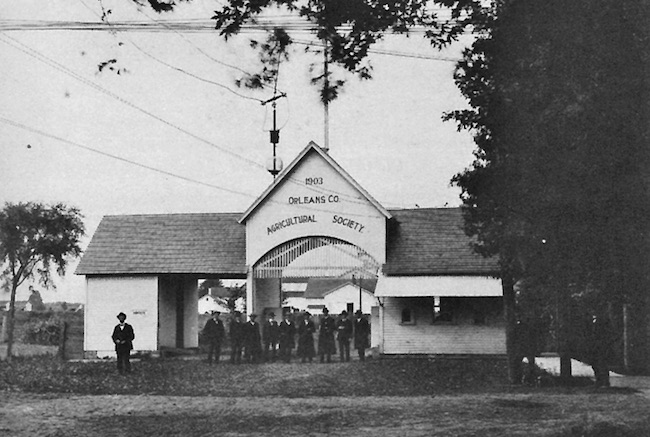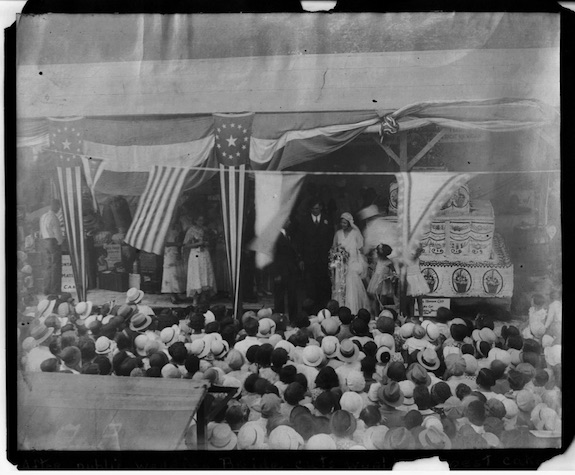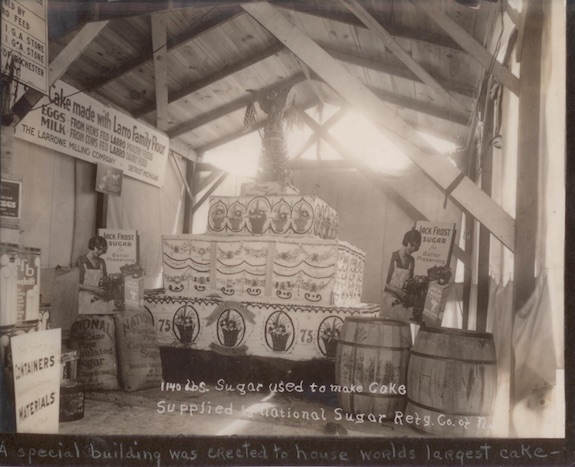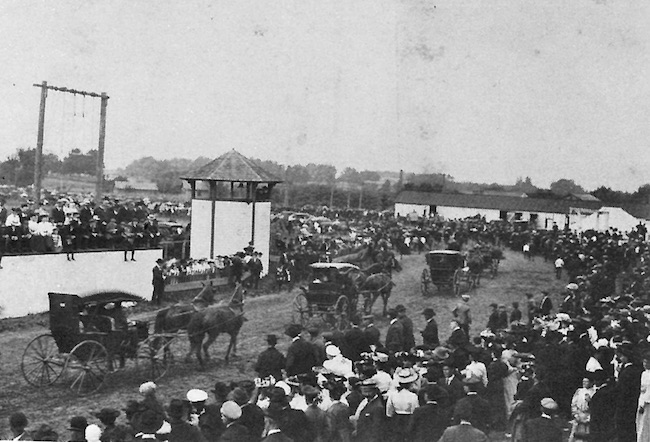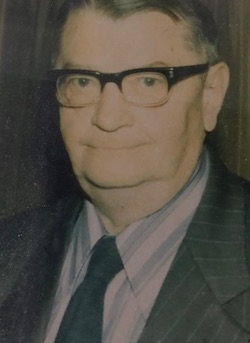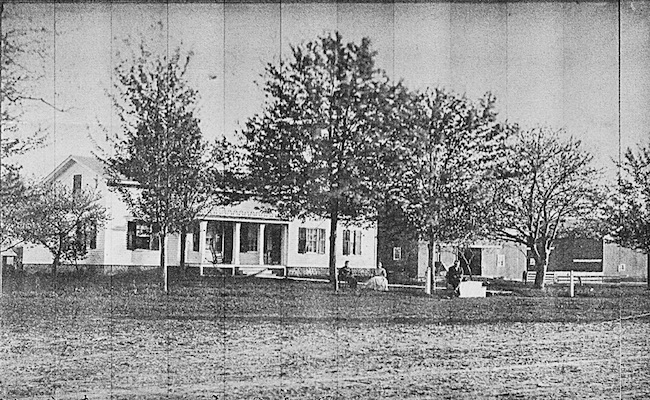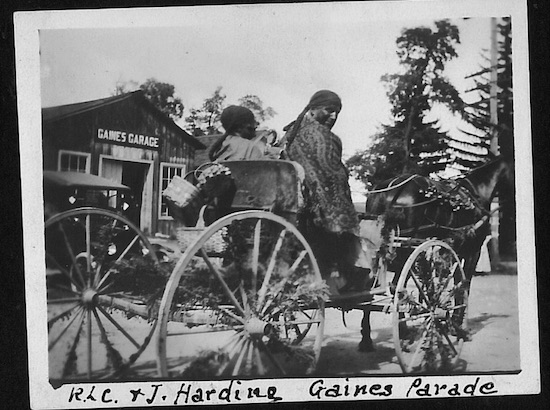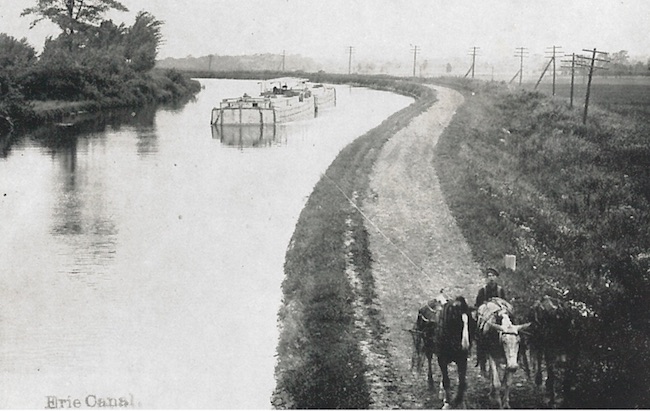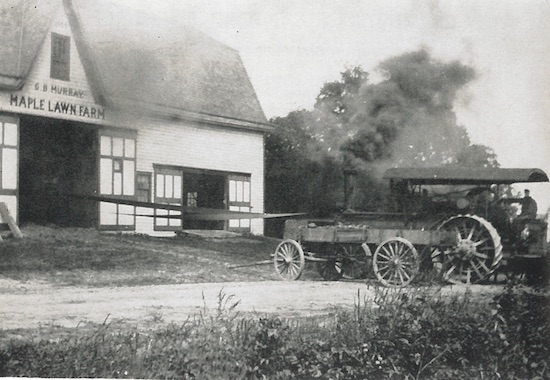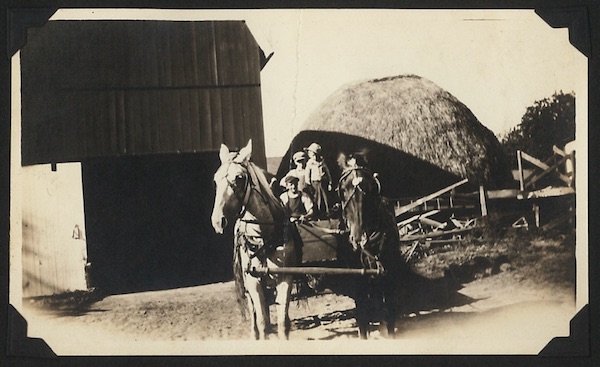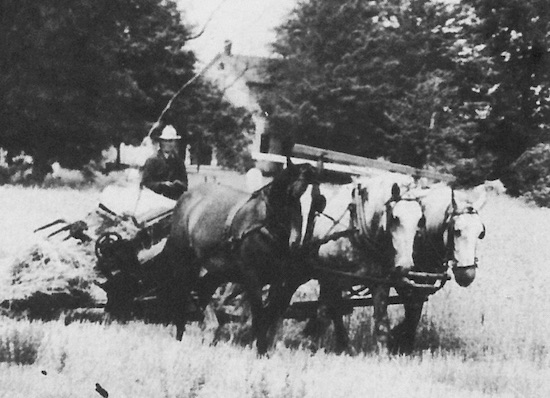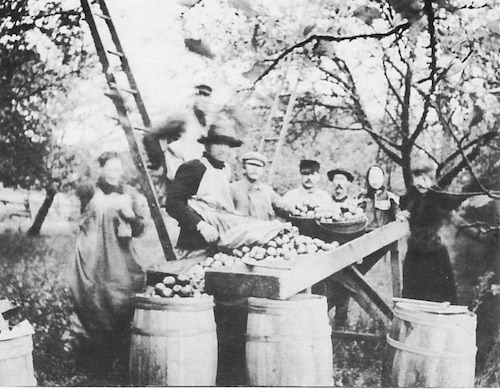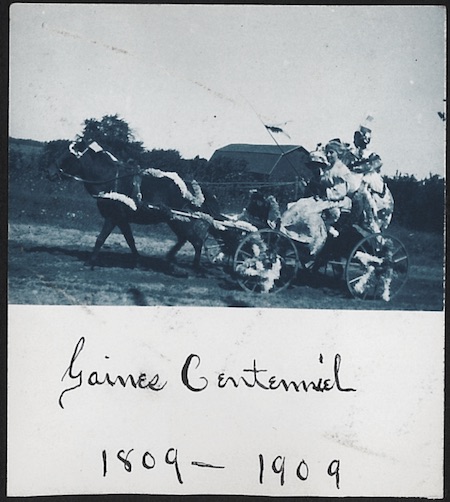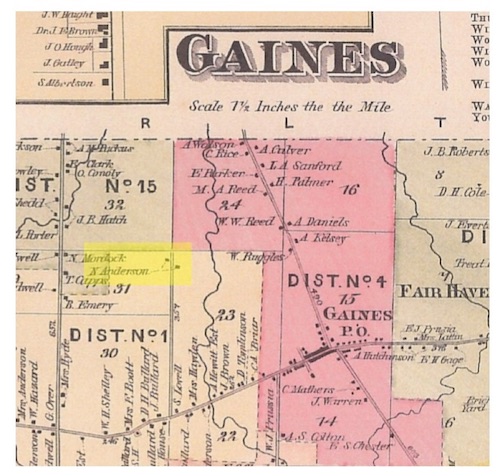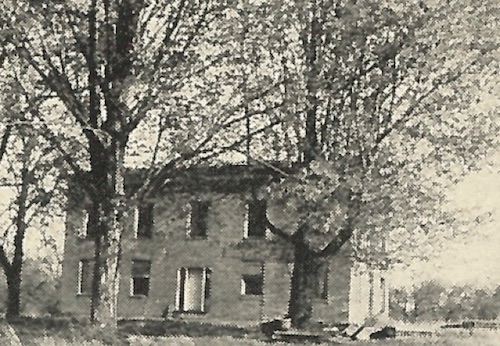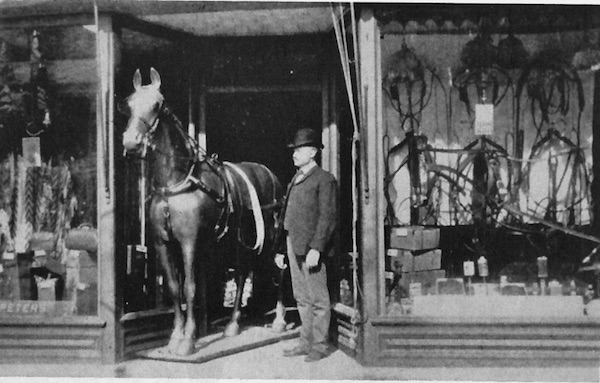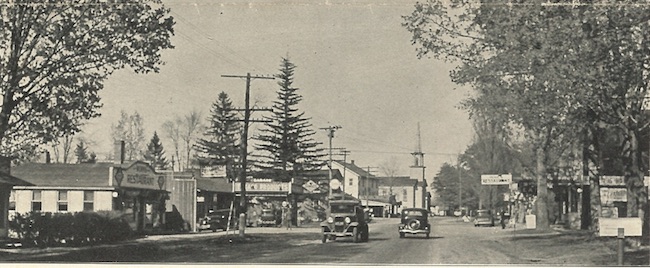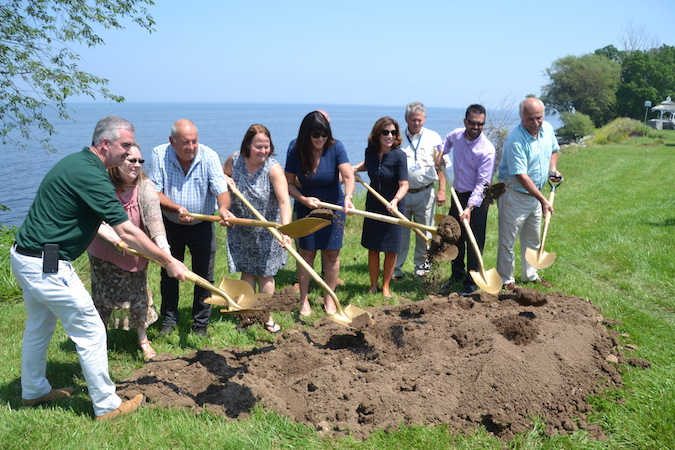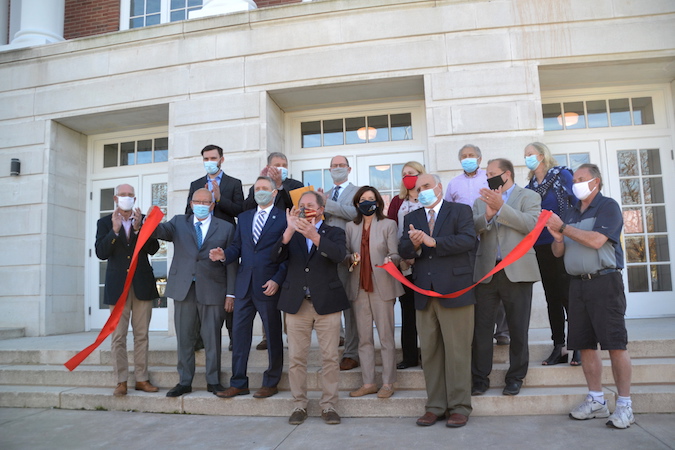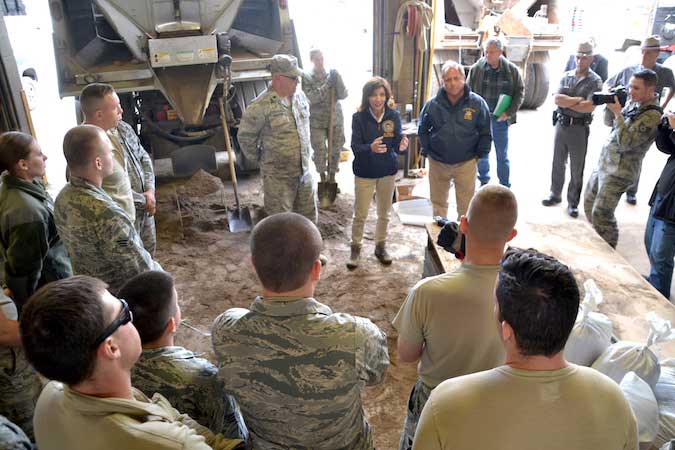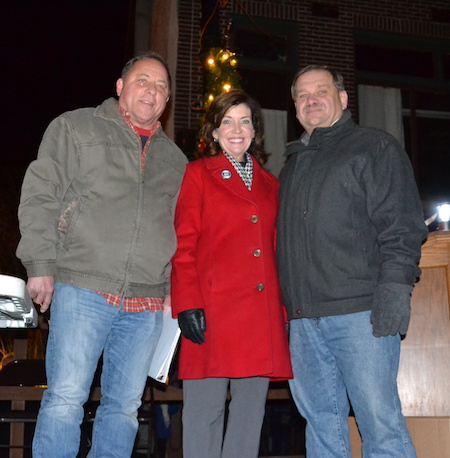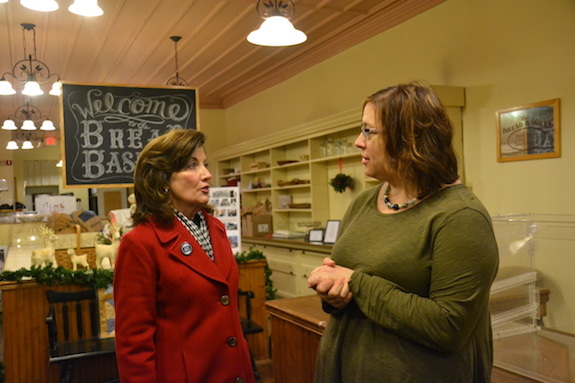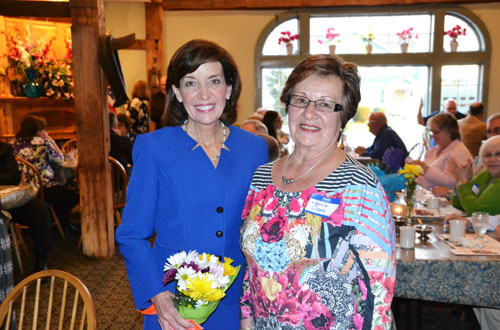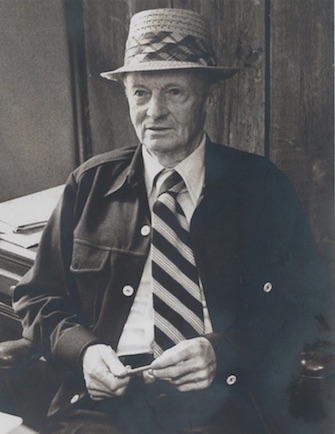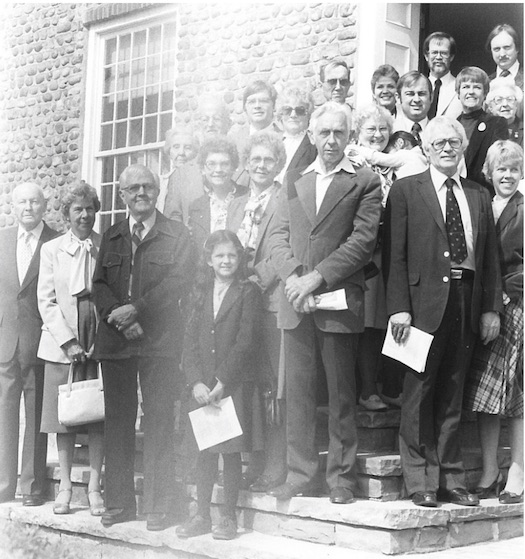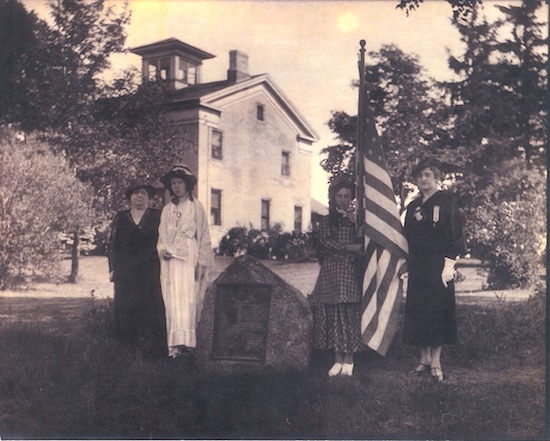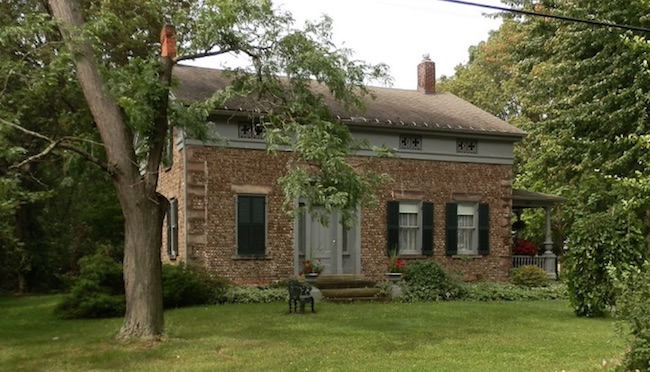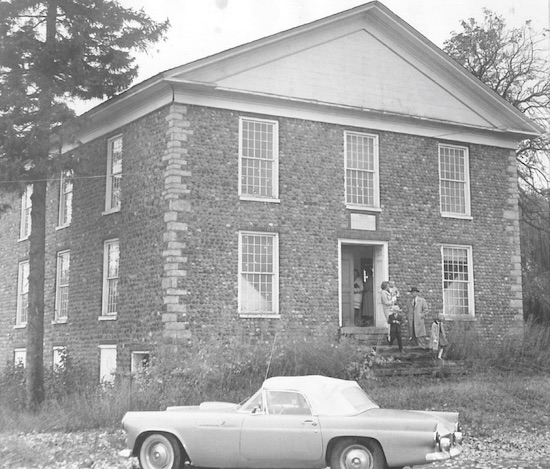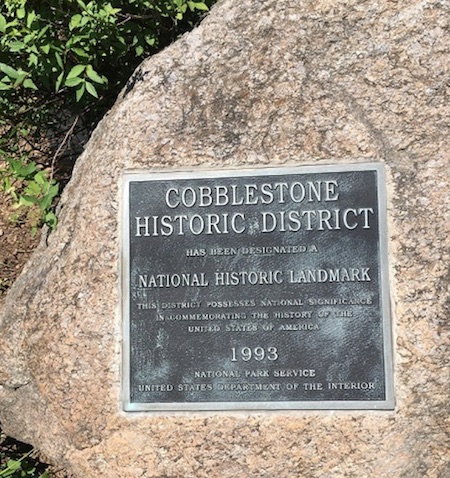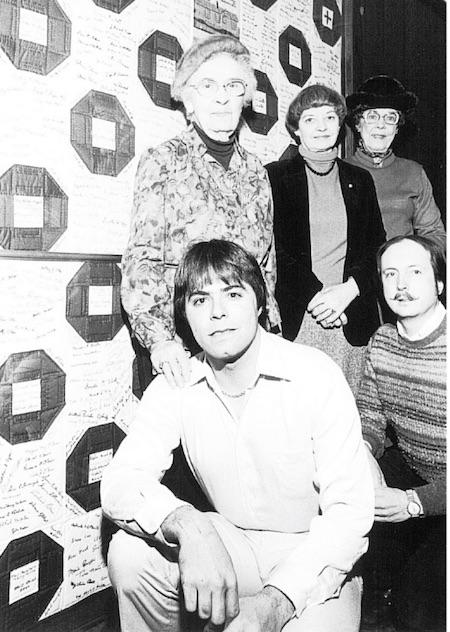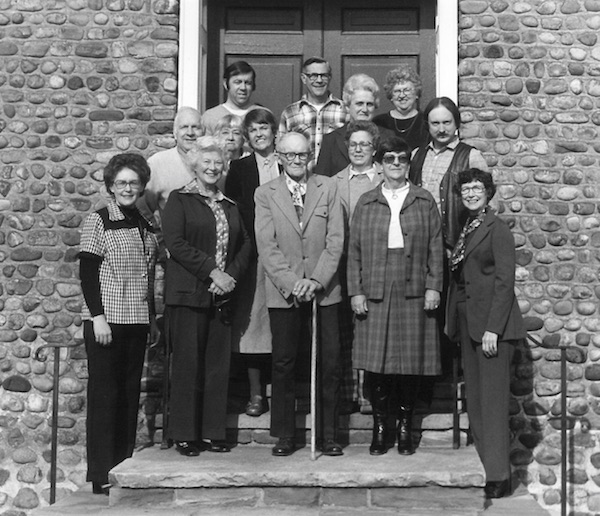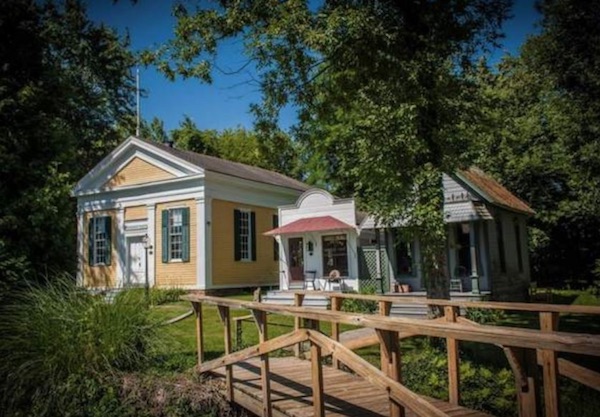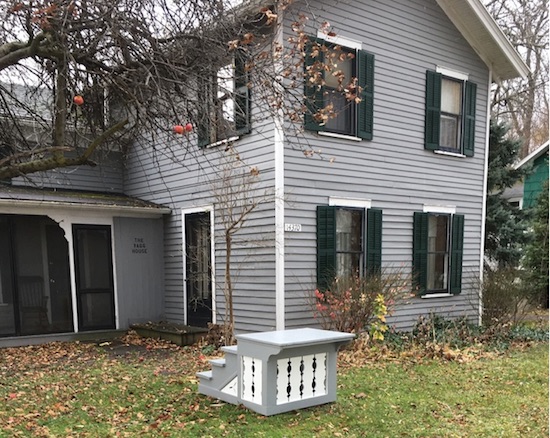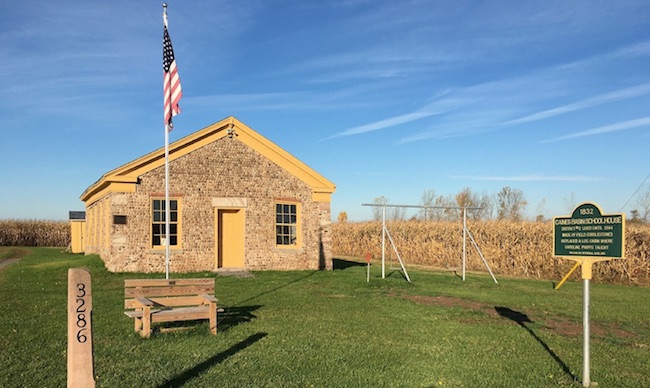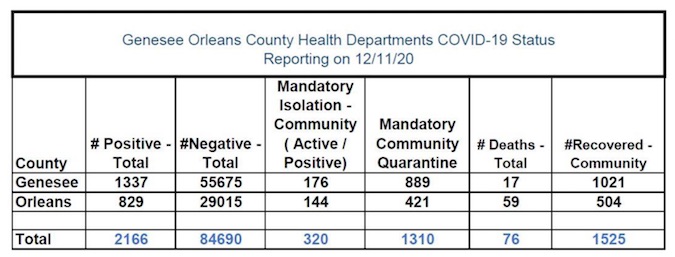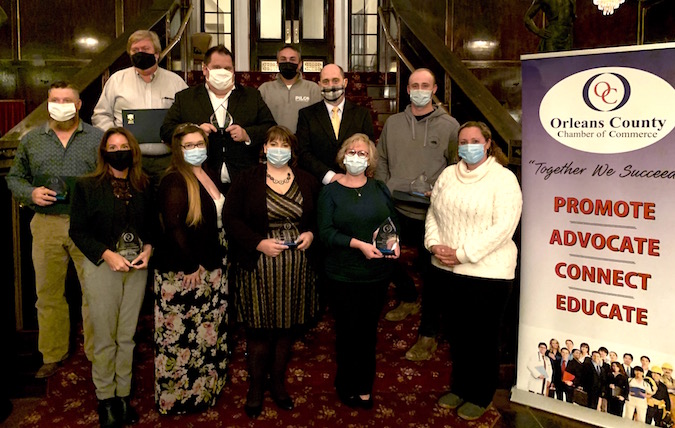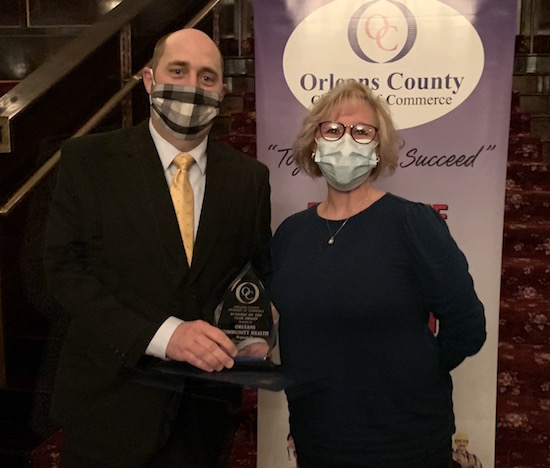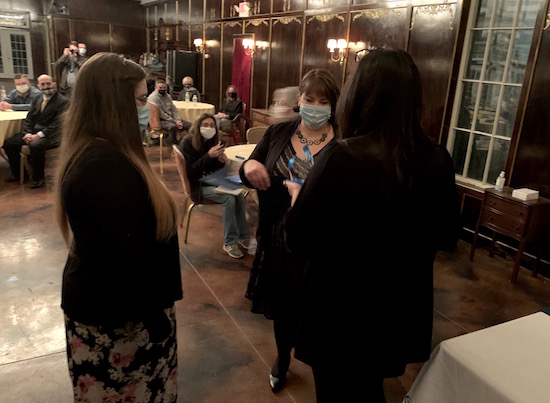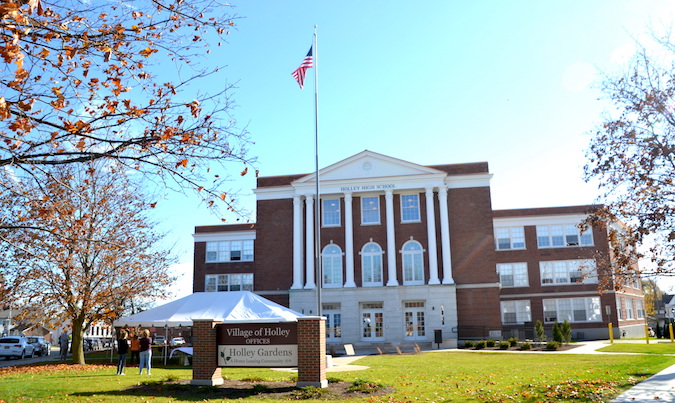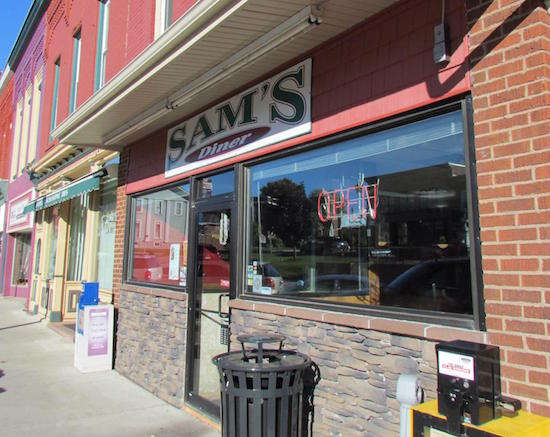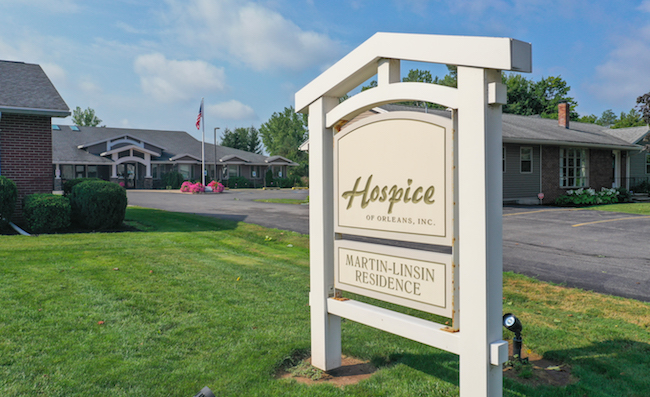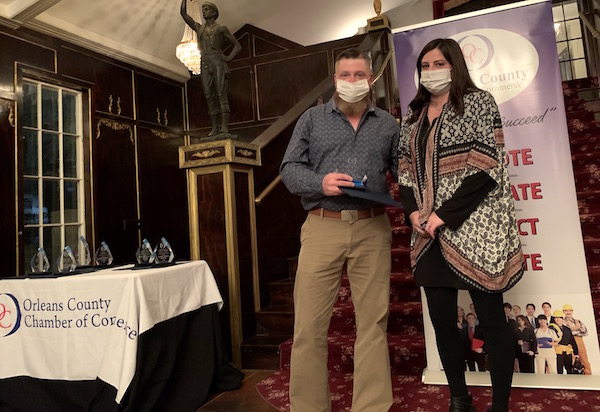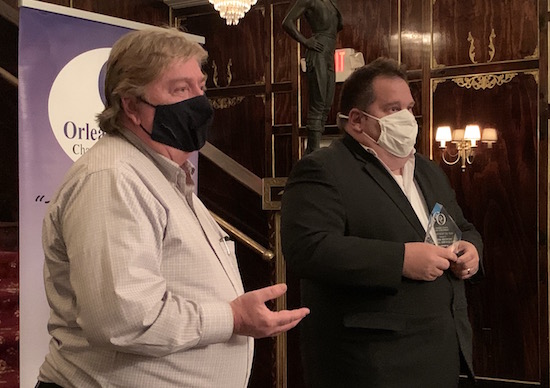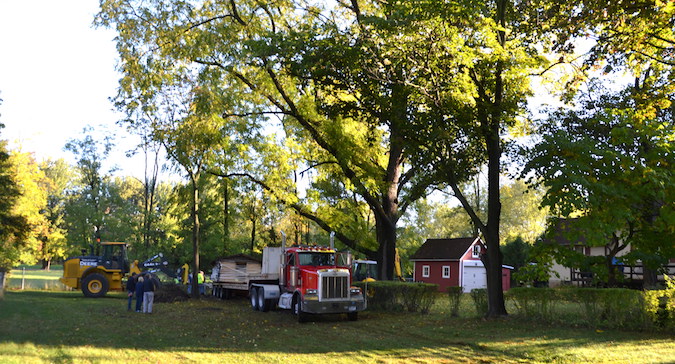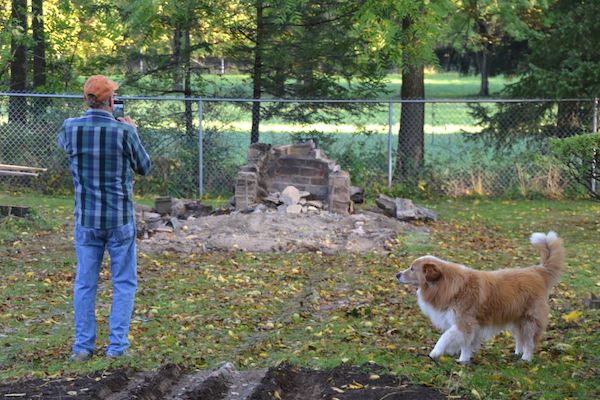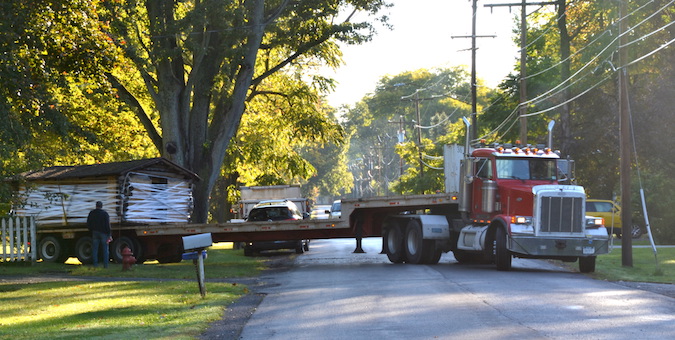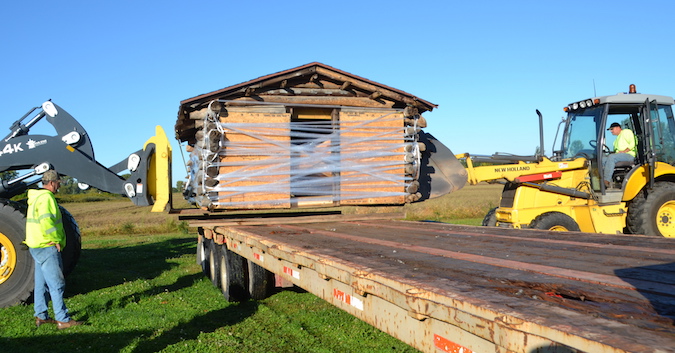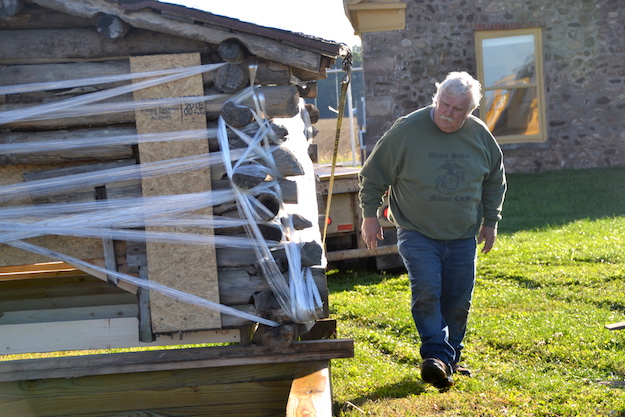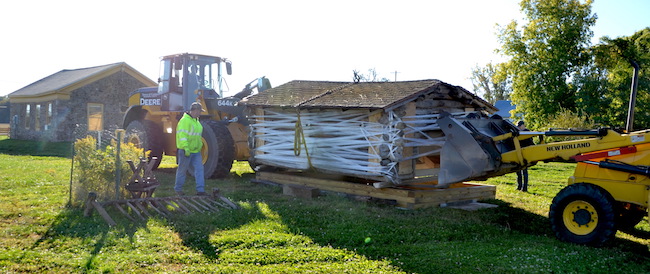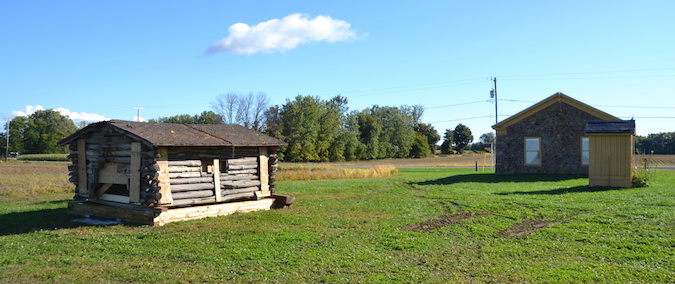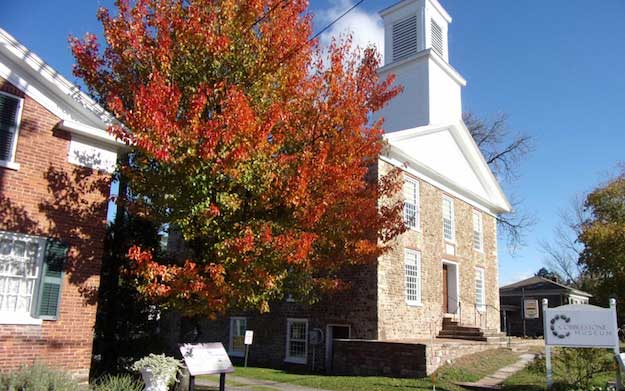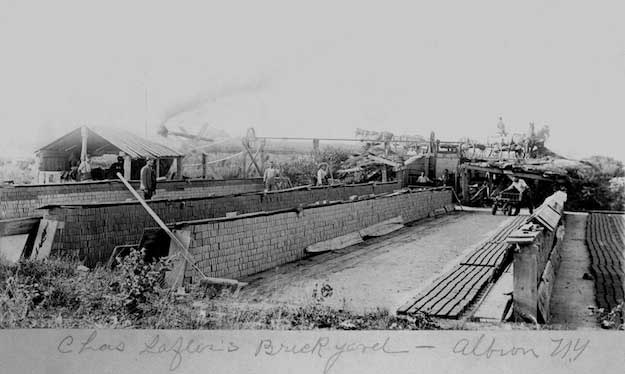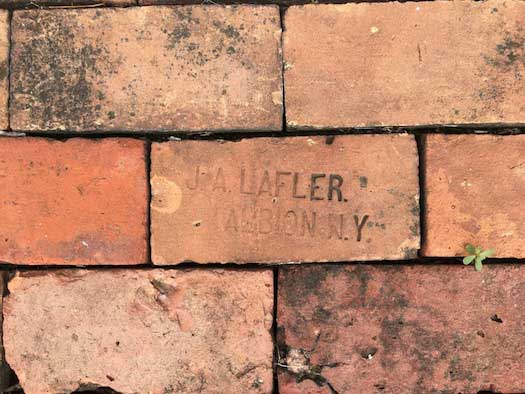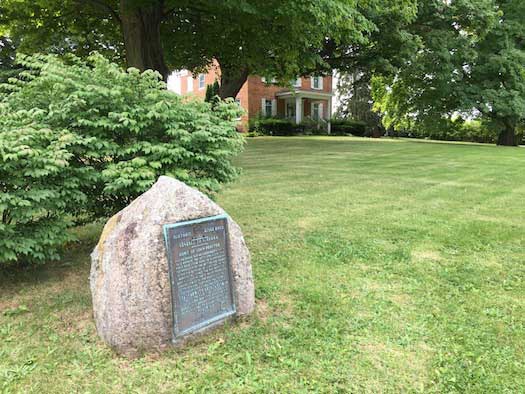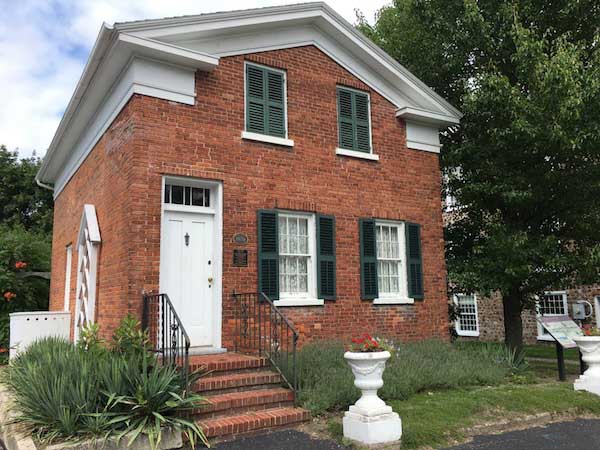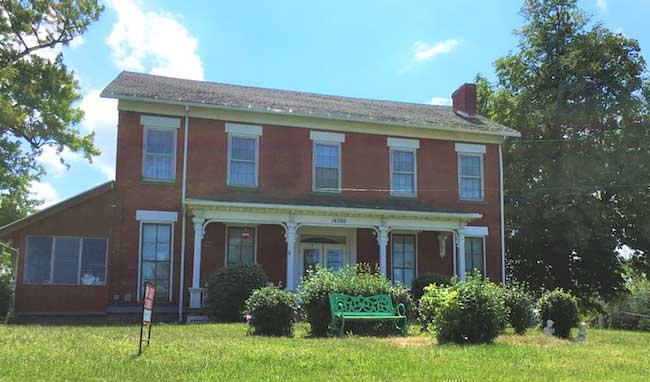Each year since the Orleans Hub started in 2013 we’ve honored a group of Outstanding Citizens who stood out the past year for extraordinary contributions to improve the community.
Orleans County is fortunate to have many citizens who give of their time, talent and money, without seeking any fanfare. This past year, with the Covid-19 pandemic, many residents pushed projects through to completion or stepped up as volunteers in response to difficult circumstances.
Medina woman makes Dog Park a reality

Photo by Tom Rivers: Alaina Zapf is shown with her dogs Batman (left) and Bailey in September at Medina’s new Dog Park on North Gravel Road.
After three years of planning and fundraising, the Medina Dog Park opened this summer at 260 North Gravel Road, next to the former composting plant.
Alaina Zapf, president of the Friends of the Medina Dog Park, led the group in raising $20,000 for the park.
Zapf wanted a place for dogs to socialize and get some exercise near the village. The dog park is a first in Orleans County. People have inquired about it from Rochester to Buffalo. Zapf is thrilled to see the response to the park, where the dogs can roam leash-free.
“So many dogs do not have adequate room to run around,” she said. “Here they can get all that energy out. They are happier and less aggressive.”
The group expects to add a small dog enclosure, more equipment in the dog agility section and a water station.
Zapf, 30, convinced the Village Board to back the project. She organized many fundraisers, including a dunk booth with several community leaders, Dog Park frisbees and other merchandize. Many local residents generously donated to the project as well.
Zapf often brings her two dogs, Batman and Bailey, to the park. When she lived in North Carolina, she would drive 15 minutes to take the two lab mixes to a dog park. When she moved to Medina, she wanted a place for her dogs to get exercise and socialize with other dogs.
Albion mom coordinates ‘Adopt-A-Senior’ program for 136 students after school year disrupted

Sara Mathes holds a T-shirt – “Senior Skip Day Champions – Class of 2020.” The shirts were distributed on May 17. Mathes coordinated a steady showering of gifts for Albion High School seniors at the end of their senior year after in-person classes and events were cancelled in mid-March.
Sara Mathes felt bad for the Albion High School seniors, including her daughter Chloe, when in-person classes were cancelled in mid-March due to the Covid-19 pandemic. There weren’t any spring sports, no prom or senior trip, and no graduation ceremony with the class together in front of 2,000 people in the gym.
Mathes wanted the seniors to feel some love from the community during a time of uncertainty and disconnection. She saw how the Ken-Ton school district adopted seniors, with residents committing to buying a senior in the class a gift. Mathes thought Albion might do the same for the 136 members of the senior class.
But she was nervous there might not be enough people willing to adopt a senior, given the difficult economic times. She floated the idea on a Facebook group for seniors and within an hour and half had 136 people committed to adopting a senior. By the end of the day she had two people or families for every senior.

Provided photo: Mekhi Rivera has a big smile when he received a gift from an adoptive community member.
She created an Excel spreadsheet to match names with seniors after getting a list of each student’s hobbies, favorite snacks and other interests. She passed the list on to the adoptive community members.
Mathes assigned the students randomly to the people in the community. From April through graduation in late June, students received gift baskets and boxes at their homes. They were very appreciative.
Mathes also coordinated getting a yard sign for each senior that was paid for by donations. The students also received T-shrts that said “Senior Skip Day Champions – Class of 2020.” That effort was coordinated by Lynn DiBella, a retired aide in the pre-kindergarten program. Angie Wolfe, a kindergarten teacher, helped with the T-shirt distribution.
Mathes was pleased to see hundreds of community members support the Class of 2020.
“It was definitely worth it,” she said. “It was to make them feel special and to celebrate them in a different way because we couldn’t celebrate them all together in the gym.”
Mathes was so thankful the community stepped forward and showed love for the seniors, including students they didn’t necessarily know.
“The seniors were able to see that Albion comes together and helps each other,” Mathes said.
Mekhi Rivera, one of the Albion seniors, appreciated the gifts from the adoptive community members.
“I am so thankful to be a part of this adopt a senior thing we are doing!” Rivera posted on the Adopt A Senior Facebook page. “Thank you for doing this and ever body else that is doing this. We are all thankful for the time and money you have put into us it means a lot.”
Mathes switched to coordinating another effort in December. Her mother-in-law, Brenda Winters, lived in one of three houses badly damaged by a fire on West State Street. Local residents again were quick to volunteer to help.
“The community has shown such an outpouring,” Mathes said. “It’s been amazing and definitely helped her get through this.”
Developer completes massive transformation of former Holley High School
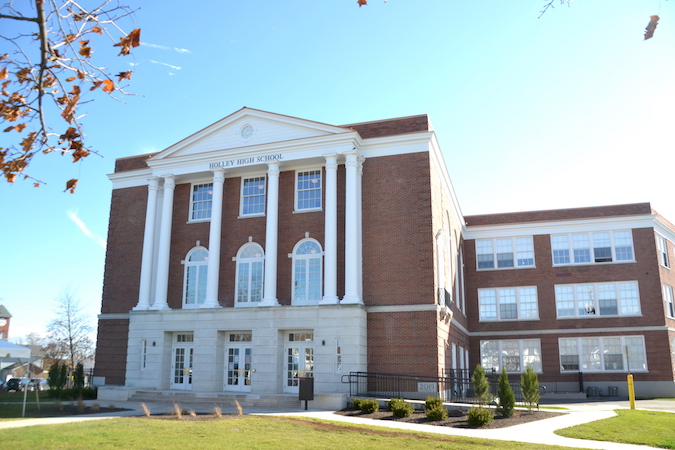
The transformed former Holley High School has new columns, windows, paint and a major overhaul inside for 41 apartments and the offices for the village.
For years, even decades, the Holley community has longed to see one of its most prominent buildings get an overhaul. The former Holley High School closed in 1975. A business, Liftec Manufacturing, used part of the space but went bankrupt in the mid-1990s. The building was left vacant, and often was the target of vandals for more than 20 years.
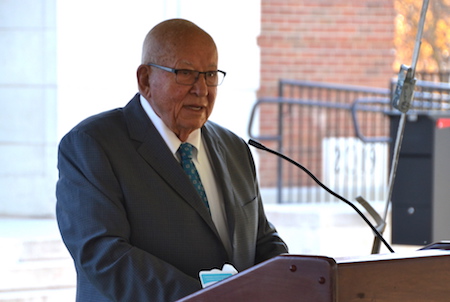
Nelson Leenhouts, chairman of Home Leasing and Home Leasing Construction, celebrates the $17 million transformation of the former Holley High School during a ribbon-cutting in November. The construction project took two years, with the building turned into 41 apartments and the Holley village offices.
It pained the Holley community to see its gradual demise – the many broken windows, peeling paint, rotted columns and a fate that seemed destined for the wrecking ball.
Holley village officials reached out to developers over the years, pitching the site for apartments and other uses. But a deal never came together – until 2018.
Home Leasing and Home Leasing Construction in Rochester committed to transforming the building into 41 apartments for seniors and the Holley village offices, with the auditorium space being a meeting room.
Home Leasing would use tax credits for investing in a historic structure to help make the project work financially. The village also committed to being a tenant which helped to seal the deal.
Nelson Leenhouts, leader of the company, has tackled ambitious projects before in buildings that have faced years of neglect. He has 50 years in the construction business. He said he’s never seen a community rally behind a project like they did in Holley.
Local, state and federal officials, including U.S. Sen. Charles Schumer, all were critical to the $17 million project’s success. Leenhouts also praised an enthusiastic community for steady encouragement along the way.
Leenhouts deserves credit for tackling the project in a small village, and seeing the it through to completion when the Covid-19 pandemic slowed construction work.
Besides improving housing options locally, the building provides handicapped accessible office space and a meeting room for the village.
But it also is a major morale boost for the Holley community, and puts a shining success on the eastside on one of the main gateways into Orleans County. It is part of major improvements in Holley, which is also tackling water and sewer upgrades and new sidewalks in parts of the village. The restored school building sends a message that Holley is on the upswing and wouldn’t back down from a major challenge – reviving a school building that had fallen into significant neglect.
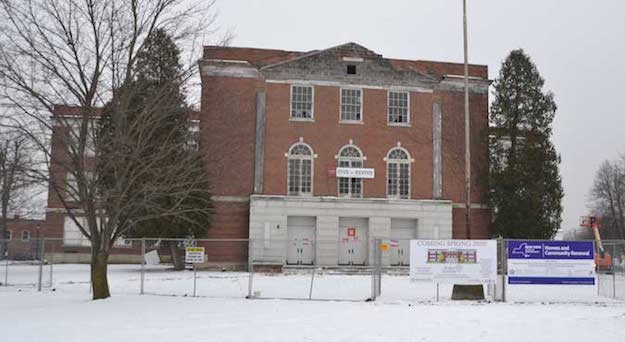
The building, shown here in Dec. 11, 2018, just before the construction work started, had steadily fallen into disrepair and was a blight at Holley’s main intersection, routes 31 and 237.
Iroquois Job Corps volunteered at food distributions throughout the county
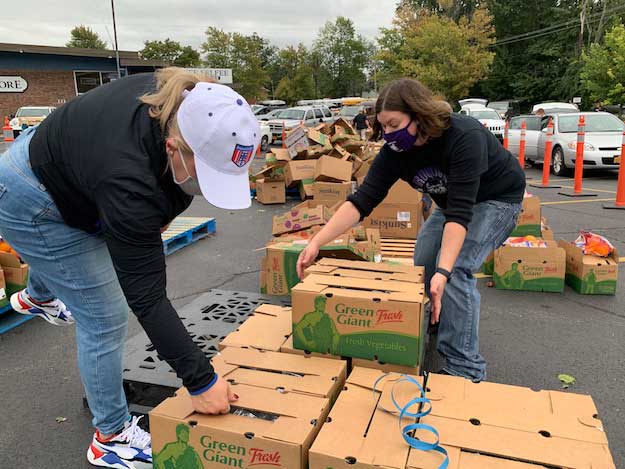
Julie Horton, left, and Hannah Donley of Iroquois Job Corps in Medina were among the volunteers on Sept. 11 during a food distribution in Albion at the parking lot of the Main Street Thrift Store. Job Corps employees volunteered over several months at distributions in Albion, Clarendon, Holley and Medina. The events would have been a challenge without them.
For many Fridays from April through mid-December, there were hundreds of boxes of food available in the mornings. Those food distributions have been in Albion, Clarendon, Holley and Medina. A long line of cars were start to form around 6 a.m. for distributions that were advertised to begin at 9 o’clock.

Krista Fiegel, an employee at the Iroquois Job Corps, rips the plastic off a pallet of boxes of food during a food distribution on Dec. 11 in Albion. She was one of four Job Corps employees who helped that chilly morning.
It takes at least a dozen volunteers to make the events go smoothly. There were many volunteers at the distributions in April and May, when many non-essential businesses were shut down due to the Covid-19 pandemic. As the restrictions eased on businesses, the volunteers were harder to come by to carry 30- to 40-pound boxes of food to trunks of cars or to set on the truck beds of pickups. They volunteers needed to be masked up – whether in stifling heat or bitter cold.
Staff from the Iroquois Job Corps proved critical to the food distributions later in the summer, throughout the fall and in December. There were often at least six Job Corps staff at the distributions and they came to ones at Holley and Clarendon – which was on the other side of the county from the Job Corps Center in Shelby. They went to ones in Albion and Medina, too, and they tackled the tasks with zest.
Some events there would be extra produce and it would need to be sorted and put into boxes. It wasn’t pre-boxed like the meat and dairy boxes. The Job Corps personnel worked hard, without complaints and were well organized.
Without them, the organizers say the food distributions would have been difficult to pull off, especially later in the year.
Gaines historical buff helps relocate 1930 log cabin to cobblestone schoolhouse
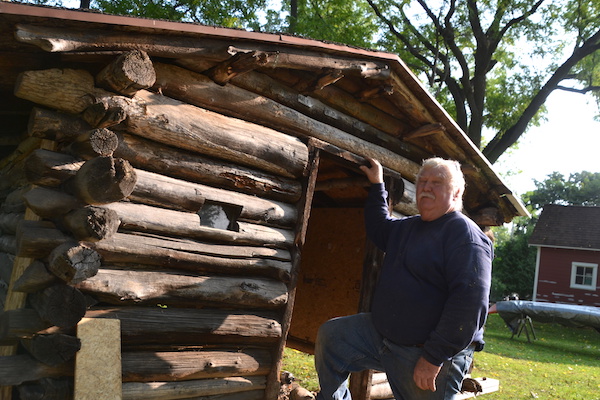
Rick Ebbs is shown in September with a log cabin from 1930. He orchestrated moving the cabin from an Albion backyard to behind the Gaines Basin cobblestone schoolhouse.
When a log cabin from 1930 was settled onto a foundation behind a cobblestone schoolhouse on Oct. 1, Rick Ebbs let out a sigh of relief.
“I was worried it would fall apart,” he said after the cabin made a 4-mile journey on a flatbed trailer.
Ebbs, a local carpenter and historical enthusiast, coordinated moving the log cabin from an Albion backyard to the behind the school, which is owned by the Orleans County Historical Association.
The log cabin was built by Boy Scouts and one of their dads in 1930. Ralph and Patricia Moorhouse agreed to donate the log cabin after being approached by the Historical Association, which wanted to display and preserve the authentic cabin.
Mrs. Moorhouse’s father, Faris Benton, was one of the scouts who built the cabin with help from his father, Fred Benton. The scouts dragged logs from the nearby woods. They built a fireplace on the inside and outside. That fireplace deteriorated over time but will be reset and repaired in its new location.
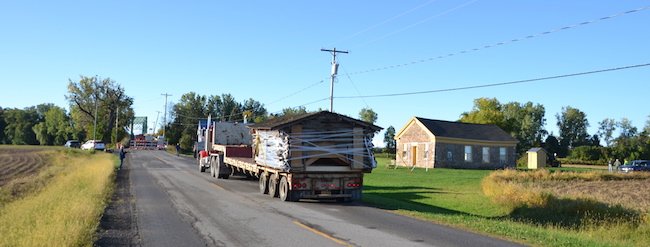
Rick Ebbs reached out to Keeler Construction, which moved the long cabin on Oct. 1 from Linwood Avenue to the former schoolhouse on Gaines Basin Road. Ebbs also was able to line up help from the Town of Gaines Highway Department.
Ebbs had the delicate task of bracing the inside of the cabin, to give it structural support when it was picked up with a fork lift and set on the flatbed. He put plywood sheets inside the cabin with cross-bracing to help keep the cabin together for the trip.
The 10-by-14-foot log cabin had withered in recent years, partly due to woodchucks. They damaged the concrete floor causing it to heave.
The reinforcements from Ebbs worked just fine. The cabin didn’t buckle when it was picked up with fork lifts, or when it headed down the highway, or when it was set down on a concrete pad with a new wooden base for the cabin.
It’s in a more visible site near the Erie Canal next to the historic Gaines Basin No. 2 cobblestone school, which was built in 1832. It is the oldest documented cobblestone building in the area.
The Historical Association thought the log cabin, which was built by children, was a good fit next to a school.
Ebbs was impressed with how well the scouts built the cabin. Despite some deterioration and rot, the structure has held up remarkably well for nearly a century. Thanks to his efforts, it should stand for a long time to come for the community to enjoy.
Church volunteer served others despite fight with cancer

Angela English carries a sack of cabbages for the food pantry at the Lord’s House on Dec. 12, 2015. This was at Community Action in Albion when the Albion FFA unloaded produce donated from local farms. English took on many roles to help the church serve the community.
Angela English was a bright light in the Albion community, coordinating a Toys for Tots program, keeping a food pantry stocked at the Lord’s House (a church run by her parents), and offering enthusiastic support at her kids’ sporting events, cheering for them and their teammates.
English was 37 when she passed away on Oct. 19. She was diagnosed with cancer on Dec. 27, 2019, and started chemotherapy last January.
Her son Omar is 17 and graduated in 2020. Her daughter Olivia is 12 and in the sixth grade. Angela was in the stands at her son’s soccer games and her daughter’s basketball contests.
Angela served as missionary at the Lord’s House, a church led by her father, Eddie English, and mother, Rose. Mr. English is the church pastor. His daughter was a praise leader, pastor’s aide, sound system technician, lyrical dancer and the Toys for Tots coordinator.
The church has run the Toys for Tots since 2008, serving about 40 families. In some years, they partner with the Orleans County Sheriff’s Office, which delivers the toys to the church.
Eddie and Rose English have been leading the Lord’s House since it started 15 years ago in downtown Albion. They renovated a former United Methodist church in Waterport, after acquiring the site at an auction in 2011. The building had been vacant for 20 years.
Angela English has been a big part of the journey and the Lord’s House mission to reach out to the community.
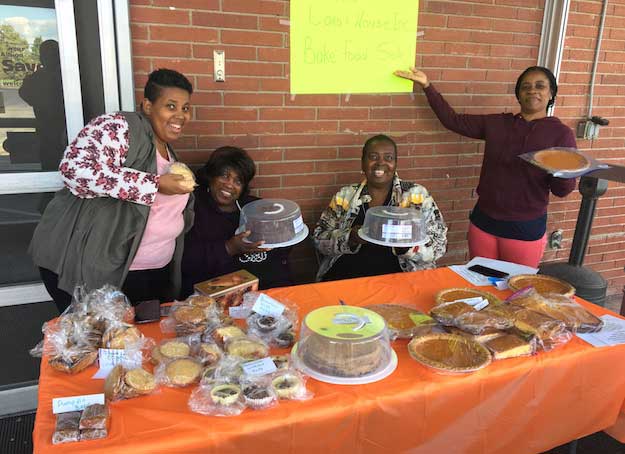
Members of The Lord’s House in Waterport sold sweet potato pie and many other baked goods at the Albion Save-A-Lot in this photo on Sept. 29, 2018. Pictured from left include Angela English, Brenda Winters, First Lady Rose English and Nadine Johnson.
K of C leader gives veterans a fitting tribute on Courthouse Square
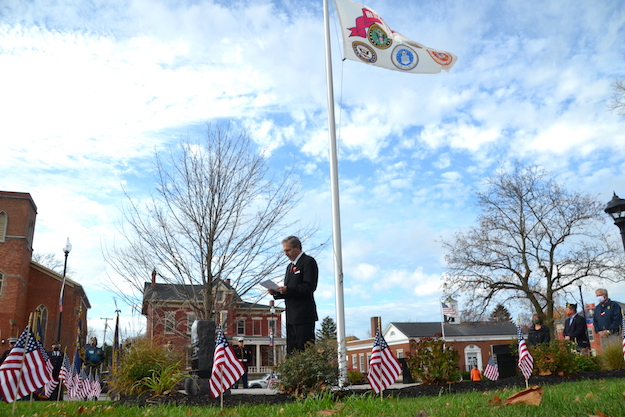
Greg Dugan, the grand knight for the Knights of Columbus in Albion, speaks to a crowd of about 50 at a dedication ceremony on Nov. 11 for a new memorial for veterans.
Greg Dugan, an Albion barber since 1991, has cut hair on thousands of heads over the years. Many of his most loyal customers have been veterans.
Once they are in the barber chair, Dugan said many veterans open up and share about their experiences, including in combat.
He mentioned the late Albion Town Justice Bill Larimer, who was a POW in World War II. He has cut the hair for other World War II veterans and people who served in Korea, Vietnam, Afghanistan and Iraq.

Members of the Honor Guard were present on Nov. 11 for a dedication service for a new veterans’ memorial at Courthouse Square. The Knights of Columbus, Albion Council #1330, took the lead in the project.
“I’ve had contact with so many veterans, young and old, since 1991,” Dugan said before a dedication ceremony on Nov. 11 for a new veterans’ memorial on the Courthouse Square.
Dugan and the Knights of Columbus led the project, which took a little longer due to the Covid-19 pandemic.
There is a new flagpole, granite benches and a headstone for the monument. The headstone includes the inscription: “Dedicated to our courageous brothers and sisters of this community who served our country in times of peace and war. We thank them for their service. And especially to those who gave their lives in that service. May God grant them eternal rest.”
The stone includes the insignias of the U.S. Army, Marine Corps, Navy, Air Force, Coast Guard, Army National Guard and Merchant Marine.
The new flag pole includes a flag that recognizes the different branches of the military.
The memorial includes two granite benches. One bench has an inscription, “To Commemorate.” The other has the words, “To Heal.”
Dugan and the Knights of Columbus pushed the project to completion and put a fitting tribute for veterans in one of the community’s highest profile locations.
Dugan has been an active leader for the K of C in recent years, leading the group in many parades around the county and organizing a “Blue Mass” at Holy Family Parish in Albion to honor and pray for law enforcement officers, corrections officers, coroners, firefighters and medics.
Dugan said he has deep appreciation for first responders after they saved his life when he was critically injured in a motorcycle accident on Aug. 6, 2012. In that accident Dugan broke both knees, both wrists, separated his pelvis, fractured his left hip, and lacerated his left leg.
That accident has turned him into a very strong advocate for first responders and veterans in the community.
“Thank you for taking the time to remember our veterans,” Dugan told the crowd during the dedication on Nov. 11. “They never gave up on us and we can’t give up on them.”
Retired museum director adds another asset to historic Childs hamlet
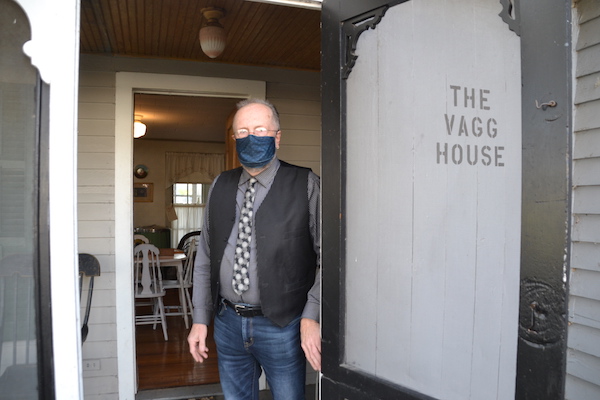
Bill Lattin welcomes visitors to the Vagg House on Nov. 7 following the Cobblestone Museum’s annual meeting. Lattin led the transformation of the Vagg House, at the corner of routes 98 and 104, into a home decorated in the 1920s and ’30s. The event on Nov. 7 was the first public event at the Vagg House since it was redone and added to the museum’s campus.
Bill Lattin has been a caretaker and storyteller of Orleans County history for the past 50 years. He is officially retired as Orleans County historian and Cobblestone Museum director. He served in those roles for 35 years. (He retired from the museum in 2010 and from the county on Dec. 31, 2014.)
But he remains an active force in preserving important local sites and documenting history. In 2020, he helped relocate a log cabin built by Boy Scouts in 1930. It went from an Albion backyard to behind a cobblestone school built in 1832 on Gaines Basin Road. Lattin has been a key worker on saving that school in recent years. He has handyman skills and deep connections to rally the community to a cause. That school and the log cabin are recent examples. But that mission started long ago. He was a key leader of the Save the Tower committee that raised $30,000 in the mid-1970s for the Civil War Memorial at Mount Albion Cemetery. Lattin has given new life to many local structures.
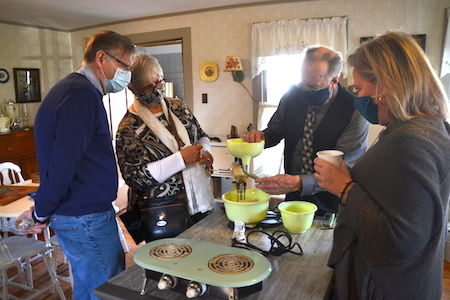
Bill Lattin shows Doreen and Gary Wilson a 1930s food mixer and a green enamel hot plate on Nov. 7 during the first public tour of the Vagg House. There is also a Kalamazoo kitchen range that was made in 1935. The Vaggs used it for heat as well as cooking. Museum Trustee Maarit Vaga is at right. Visitors will notice a big difference between the 1920s-era Vagg house and the cobblestone Ward house, furnished in the style of the 1880s.
He doesn’t seem to be slowing down. At the Cobblestone Museum this past summer, Lattin and his grandson Freeman painted several of the buildings on the Route 98 campus.
The museum acquired the Vagg House at the corner of routes 98 and 104, the main intersection in Gaines and the Childs hamlet. The site was most recently owned by Lattin’s partner, the late René Schasel.
Lattin led the efforts to curate the former home of blacksmith Joe Vagg and his wife Nellie, who was active in the temperance movement. The house includes many of Schasel’s antiques, with many of those items given to the museum in Schasel’s memory through his estate, which Lattin is co-executor.
Lattin also was able to find additional antiques to decorate the house in a 1920s, ’30s theme, with many of the early electrical appliances.
(Lattin even built an outhouse for the site to help it match the others on the museum’s grounds.)
The Vagg House is a new “jewel” in the Cobblestone Museum’s crown, said Doug Farley, the museum’s current director. The house can be used for small gatherings of less than 30 people, such as meetings, rehearsal parties or teas, and other museum events.
Lattin continues to be a mentor and strong supporter of Farley and other historians in the community.
Medina couple pushes modern public art murals to enliven alleyway

Chris Piontkowski of Cheektowaga paints a floral-themed mural on a cinder block building on Proctor Place, a one-lane street that starts near Rudy’s Diner. He is shown on Nov. 28. This is one of four large-scale murals added to Medina last year.
Tim Hungerford and Teresa Misiti, a married couple in Medina, are pleased to see so much investment in the Medina community in recent years, especially in the downtown business district.
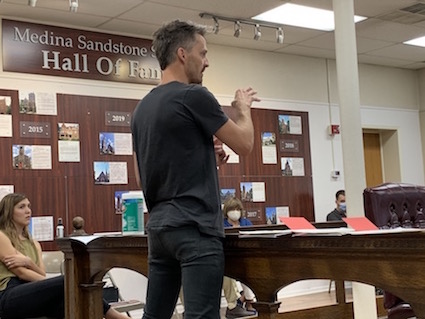
Tim Hungerford and Teresa Misiti met with the Village Planning Board on Aug. 4 to discuss regulations for public art.
The two are among those investors, doing a major renovation of their loft apartment in the downtown and at the restaurant they own, Mile 303.
Hungerford and Misiti believed there was a missing piece in the community: dramatic modern art. They also felt there were some rough spots in the downtown, mainly back walls off Main Street.
They are part of the Form Foundation, a non-profit looking to bring public art to Medina. They coordinated having four large-scale murals off Proctor Place, a one-lane street a block from Main Street. Hungerford and Misiti met with village officials and found a way to accommodate public art in a historic district.
The projects have created another attraction in Medina without altering the historic structures. The murals are painted on cinder block walls. Hungerford and Misiti pushed to get the murals done during the pandemic, wanting to bring some positive energy during a difficult year.
They plan to replace the murals every two years and hope to add more locations.

Chuck Tingley shows a traveler with a message, “Fake It Til You Make It!” with this mural on the back of 410 Main St., which faces Proctor Place, a one-way street a block from Main Street.

Julian Montague, an artist from Buffalo, painted two walls of a building at the corner of Pearl Street and West Avenue. The walls are 14 feet high and 80 feet long. Montague paints geometric patterns with eyes and mouths to give the mural some added personality. “It’s playful and a little weird,” he said.

The “Canalligator” mural was the first of four in Medina in 2020. Artist Tim Meyers painted the “Canalligator” that stretches more than 50 feet on a cinder block building on Proctor Place.
The Orleans Hub usually has an awards program for the honorees. It is unlikely a ceremony with all the attendees and their family and friends will be allowed soon due to Covid-19 restrictions and concerns. We’ll work out a way to present them with their awards.
